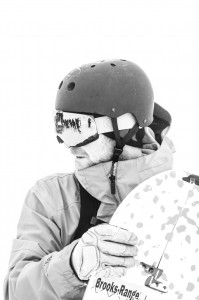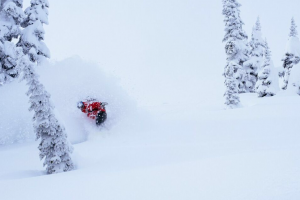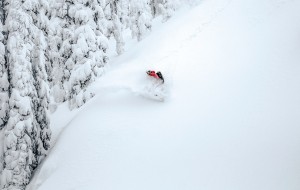Q&A with one of the first AMGA Certified Ski Guides on a splitboard

If you were a hardcore snowboarder in the 90s it’s likely you were charging the park and pipe with distant dreams of taking your passion to the X Games. If you were Eric Layton in the 90s, you would split your own board, head to the backcountry and never look back. It’s no surprise that Eric’s jump-start on splitboarding has lead him to become one of the first American Mountain Guide Association Certified Ski Guides on a splitboard, and a pioneer in the growing splitboard guiding industry. As an ambassador for Brooks-Range, Eric has been tasked with pushing our mountaineering equipment to its limits, deep in the backcountry of British Columbia, ascending Mt. Shasta, Heli Skiing in Alaska, and splitboarding in the far reaches of South America.
So where are you from, and how did you get into snowboarding?
I’m originally from San Diego, and have been going to the mountains since I was three when my parents put me on skis. I switched over to snowboarding when I was about 13, and would go on trips with friends every weekend. After high school I visited Tahoe for the snowboard scene and it just blew my mind. I’d never been in that much snow. I moved out the next year and have been in Tahoe for 20 years now.
 How did you transition from inbounds riding to backcountry splitboarding?
How did you transition from inbounds riding to backcountry splitboarding?
When I got into snowboarding in the 90s, it was all focused on park and pipe. Everyone had a dream of being a pro snowboarder. I didn’t like the competition as much, so I started going more into the backcountry with friends. I started splitboarding in the season of ‘97/’98 with the old Burton interfaces that would work great one day and would break or ice out the next day. I spent my days bootpacking because when splitboards first came out they weren’t efficient and I’d end up carrying it. It was a love/hate relationship until around 2000 when the change started to happen, when there were better bindings and technology.
So what does a year in the life of a splitboard guide look like?
I spend the winters in British Columbia and the spring in Alaska, although I’m constantly on the road developing guiding and clientele. I go up to Canada because there’s so much guiding work there. There’s not a whole lot of work down in the states with splitboarding, so I started my company Splitboard Guides International. The direction of the company is to offer unique splitboard trips throughout the world and really all about helping the younger generation. It’s about giving them the knowledge and the power to understand avy safety and skills so they can make their own decisions in the backcountry. They’re going to go out regardless, I just want them to be safe.
You were the first snowboarder in the US to pass the AMGA Ski Exam on a splitboard – how did that feel and what did it take to get there?
Oh, it definitely felt incredible, it’s an honor. It was great because I thought I’d get the certification on my skis then jump back to my snowboard. That’s what people kept telling me to do but I kept fighting it and calling the AMGA and asking “why not?” Now the AMGA is really helping the sport grow. The fact that AMGA opened up their certification to splitboarders is huge and people are excited about it.
 How does this tie into the progression of splitboarding?
How does this tie into the progression of splitboarding?
Splitboarding is really on the fast track now that the AMGA certifies splitboarders, and guys like Jeremy Jones are pushing the technical limits of snowboarding. I think what we’re going to see is people are ready to cut the ribbon and ready to run the race. In the next couple years we’re going to have an influx of guides around the world that are going to get certified, it’s not just going to be myself and Brendan Burns….that’s going to spark people into creating guiding companies. People are just going to be ready to hit it hard in the next year or two.
Price is usually a barrier for people who want to get into splitboarding – do you have any tips or recommendations on the initial setup?
I’ve split my own board, that’s one thing you can do yourself. For that you’ll need a saw, a steady hand cutting the board down the middle, snowboard bindings and a slider track adapter. With the skins and an adapter plate, you’re looking at $300-350. You can get into it relatively cheap. The performance isn’t there, but at the beginning you don’t really know what performance is. From there you can start testing things out, go to your local shop and buy a board. All boards ride differently – some people like to ride them a little shorter, some a little longer – it’s all personal preference. Don’t worry about getting a used board to start, just get out there.
Where’s the best place to find splitboard gear?
There is a lot of support online from companies such as Splitboard.com where you can find just about anything splitboard related. Chimera Backcountry Snowboards out of Utah has an amazing demo program that I’ve never seen before. They’ll ship you a board, ride it, and if you like it you can buy it at a discount. If you don’t like it, ship it back. So it’s a great way to find the right board for you.
How has your family played a part in your splitboarding career?
I’m lucky my family is incredibly supportive. It’s really hard to have a family and be a guide, but the love and support I have from my wife is huge…plus she’s also a guide. No one wants to see me gone for weeks at a time, but it’s easier to know that she understands. I’m supporting her dreams – she’s actually out guiding right now and our son is sleeping. With two guides as parents, it just makes sense that our son is named Ryder Winter.
 What’s one of your favorite pieces of Brooks-Range gear that you’ve used so far?
What’s one of your favorite pieces of Brooks-Range gear that you’ve used so far?
I’ve really been liking the Armor Jacket – I’ve been so blown away by how warm it is and the breathability of it. I’ve worn it touring through warm temps down low, an inversion halfway up, then at the top where it was cold, and the jacket never came off. The breathability is incredible and it’s waterproof. The hard-shell is really cool and the construction is fantastic, I love it.
As a ski guide, I’m constantly digging snow pits to determine snow stability, that means that my Compact EXT Shovel and Scientist 35 Folding Snow Saw are an essential part of my kit. The shovel blade creates a smooth wall in which to perform my tests and the snow science 30 saw folds away so discreetly, you almost forget it’s there.












